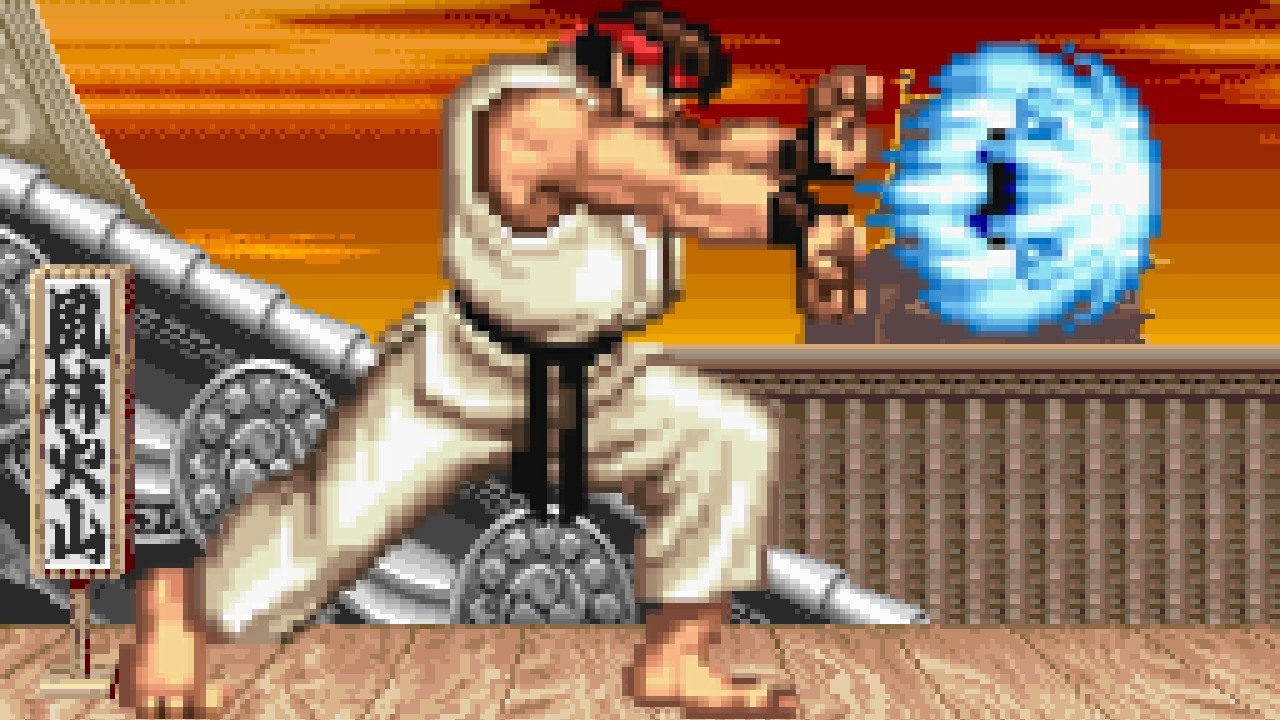Chapter 4: Controlling Space

A big part of controlling the match is controlling not just the opponent, but the space around them as well. Really seeing how moves can control a space is pretty rare- most people just steal tactics theyve seen someplace else (dont get me wrong- learning (“stealing”) is fine, but can only happen after someone elses innovation. Innovating is best). They can understand that they work, and see it in practice, but lack the vision to have seen it for themselves. This is because most players look at the game and its moves in very concrete terms. They evaluate moves in terms of things like “priority”, speed, damage, comboability, etc. These things are important, and while top players may often speak that language, they understand it all at a deeper level. Usually, they have an almost intuitive feel for the more abstract characteristics of moves- way that they can control a space, closing down options for the opponent, and forcing them into certain responses.
You want to understand your moves not as some distinct kind of event, but as an extension of your overall on-screen presence. Its basically a different way of thinking about familiar moves. This may sound stupid, but it can have serious and powerful effects on your game. Thinking like this is easy enough in the case of most normal moves- theyre you sticking out parts of your own body. The challenge is to think in the same kind of integrated way about special moves as well.
A good example is Ryus fierce FB (this example applies (to varying degrees) to a lot of games- HF, Super, ST, A2, 3s (ex FBs only), etc.). Its a fireball- obviously nothing new- and the fierce version just travels a little faster than the other options. So what? If you think about it in the historical role of FB as a range weapon, then maybe theres not much to say. But try thinking of it instead as a poking move, much like a low forward (or whatever poke you happen to like). If you only do it when the opponent is at a certain range, it really does work like that- comes out so fast that its effectively impossible to react to, much less counter. Just like a low forward- only this one does more damage, more dizzy, and has a slightly longer range. A lot of people have trouble with this just because of the stupid distinction that a fireball is a “special” move, not a normal (though this fake distinction is being dispelled by the advent of things like the various 1-button fireballs: Cyclops fierce pulse, Megamans FB, etc.). Get over it. When youre able to start seeing the fierce FB as a poke, you develop a powerful new technique that (as proven by its continuing dominance as a tournament tactic) most people have simply overlooked.
One of the easiest ways to spot this kind of insight has always been to watch how people use their jabs and shorts. Experts virtually always make more and better use of these moves. Of course they have a similarly complete understanding of the rest of the moves- their use of jabs and shorts just stands out by contrast, as theyre most commonly overlooked. Everyone notices when some character gets a great low roundhouse, but the value and particular uses of a jab is often lost on the majority.
Take Dr. Doom from MVC2 as an example. While hes got a lot of great moves, most dont really see his jabs as anything special. Indeed, in the game at large, there are a lot of better jabs (like Dhalsims, for instance). An expert will notice a few things, however. That gimpy finger actually has incredible range, comes out instantly, and leads the rest of his body by a mile. It gets its hit sprites way out in front of any of the vulnerable remainder. Great lead for dashing in. If it hits, combo into launcher. Is this a game-breaking tactic? Hardly. Its a little thing, but good evidence of a larger overall ability to find and intuitively incorporate non-obvious uses of moves into a coherent pattern of attack. It works to open up opportunities that werent there before.
Understanding the real details of how all your moves work is also the prerequisite for a more widely-acknowledged hallmark of the pros: playing “footsie”. In its pure form, this is really nothing more than a challenge to see who understands which move best controls which range. The game is won when someone sticks out something just slightly non-optimal for that particular situation, and bang, they get swept. This can really be beautiful when done well.
So. You want to really understand the mechanics of all your moves for maximum effectiveness, and to find novel ways to use those moves. Great. However, the trickiest bit is yet to come. The most difficult part of fully appreciating your moves is seeing their abstract ability to control the game space- seeing how they affect the geometry of the match.
Controlling space like this really is just about geometry. Even the metaphors we use for traps are vaguely geometrical (being “put in a box” or being “locked down”, etc.). The historical (and continued) general superiority of fireball characters is also a testament to the value of controlling space. They obviously tend to be better at that, since they can fire off little things that do it for them, leaving them free to do something else (like DP your silly butt out of the air, etc.). The best way to help establish this is probably with examples:
Effectively controlling space is what makes Dooms air photon charge in MVC2 so good. The damage is weak, and it gets completely eaten by beams, but it controls a huge amount of space. The number and angle of the individual bursts is such that he can occupy a large percentage of the screen below. You cant maneuver in there- its filled up with Doom-stuff (this is so common in MVC2 that its led to the joking observation that the rule of thumb for telling whether a characters any good is to see how well they can fill up the screen with crap. More crap = better character). Youre not going to win a lot of fights on the damage from photon charges alone, but they do succeed at things like charging meter while also closing down a lot of your opponents otherwise open attack vectors (which also causes frustration, the ill effects of which Ive discussed elsewhere).
Dooms jump fierce is also primarily effective as a means of controlling space- its not a great move for actually hitting people on its own. Its only even barely capable of hitting people in very particular spaces. What it can do well is to control a hotly contested bit of space- that through which you must pass if youre planning on jumping, superjumping, or even just walking forward. Thats valuable. Very valuable, even if the move is otherwise fairly weak. Its features like these in combination that contribute to Dooms greatness in the game overall- in addition to an unrelatedly great assist, when hes on-screen, Doom is great at controlling space- like the Dhalsim of the SF series (though Dhalsim himself is still pretty good at space control in MVC2).
The threat of Cables AHVB allows him to similarly control a huge chunk of space- virtually everything in front of him, as well as a bit above and below. Effectively attacking Cable means understanding and effectively skirting the contours of his biggest threat- finding a way to put (and keep) yourself in the spaces where you can render the AHVB irrelevant (most notably far above, below, or behind him). This is way Cable v Cable fights tend to be so stupid- neither can effectively deal with the threat of the counter-AHVB posed by the other when at the same height. As a result, they spend their time trying to stay on top of one another to drop ineffective-but-safe time bombs. Stupid.
This same type of overwhelming spatial control is also behind why Akuma was so completely ridiculous in SSF2T. Yes, he had a lot of little extras with juggling, instant recovery from dizziness, etc., but it was the air fireball that made him a monster. It wasnt just the fact that he could perform it with virtually zero recovery (since you automatically recovered once you reached the ground)- this remained constant throughout later versions where Akuma was far less powerful. No- what made the ST air fireball such a killer was the angle of the thing. Its all about geometry, baby.
In almost all situations, the move could be performed safely, and it controlled a huge percentage of the screen. It shut down a huge number of the opponents counter-attacking options. Due to the angle, even moves which had been explicitly developed to dodge standard fireballs couldnt get safely around it. To tone it down in later versions, all they had to change was that angle. Everything else about it remained basically the same, but by making the angle of the fireball more vertical, the percentage of screen that it could effectively control was dramatically reduced (though its still significant- the air FB remains a great advantage in many cases, and still because of its angle- just not as excessive as it used to be).
One of the greatest examples of the value of space control comes from David Sirlins notorious A2 Rose. Mostly he just does a ton of low strongs. Thats annoying for all kinds of reasons, but whats worse (and relevant to our concern here) is that, when hes got the right range, he doesnt even want the strong to connect. Hes using it to occupy the space in front of you, and is quite content to just repeatedly whiff. If he was making you actually block it, youd be pushed out of range after 2 of them, at most. Thats no good- it would risk letting them slip beyond Roses ideal range. Instead, he likes to let you languish right on the verge of having to block, inviting you to stick something into the space hes controlling with the high-priority outer frames of his low strong punch. When you do (and they all do), he gets to hit you, maybe do a little combo, and then put himself right back into position to continue just dominating the space immediately surrounding you. So annoying.
This list could go on and on – the point here is that behind the pretty graphics, what youve basically got going on is geometry. Particular characters use their moves to control certain areas in game space- the challenge at the highest level is to develop an intuitive feel for these mechanisms. A player with this sense can feel his characters spatial control gaps and do his best to fill them with the moves available, while also consistently positioning himself in the spots where his opponent is least able to effectively attack. Duh!
